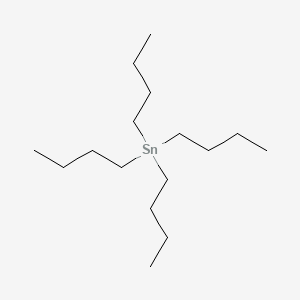D1116 | tetrabutyltin
| Toxicity | Dose | Time | Species | Model | Method | Action | Positive criterion | Reference |
|---|---|---|---|---|---|---|---|---|
| MEMBRANE POTENTIAL | 5.66±1.03 | human | qHTS-HepG2 | MMP assay | decrease | IC50 | 163 | |
| MEMBRANE POTENTIAL | 11.22 | human | HepG2 | MMP assay | decrease | IC50 | 163 | |
| MEMBRANE POTENTIAL | rat | hepatocytes | MMP assay | Negative | IC50 | 163 | ||
| Pictogram | Signal | Statements | Precautionary Statement Codes |
|---|---|---|---|
     |
Danger |
Aggregated GHS information provided by 59 companies from 10 notifications to the ECHA C&L Inventory. Each notification may be associated with multiple companies. H301 (74.58%): Toxic if swallowed [Danger Acute toxicity, oral] H302 (20.34%): Harmful if swallowed [Warning Acute toxicity, oral] H312 (74.58%): Harmful in contact with skin [Warning Acute toxicity, dermal] H315 (93.22%): Causes skin irritation [Warning Skin corrosion/irritation] H317 (16.95%): May cause an allergic skin reaction [Warning Sensitization, Skin] H318 (18.64%): Causes serious eye damage [Danger Serious eye damage/eye irritation] H319 (76.27%): Causes serious eye irritation [Warning Serious eye damage/eye irritation] H330 (16.95%): Fatal if inhaled [Danger Acute toxicity, inhalation] H341 (11.86%): Suspected of causing genetic defects [Warning Germ cell mutagenicity] H360 (11.86%): May damage fertility or the unborn child [Danger Reproductive toxicity] H372 (93.22%): Causes damage to organs through prolonged or repeated exposure [Danger Specific target organ toxicity, repeated exposure] H400 (76.27%): Very toxic to aquatic life [Warning Hazardous to the aquatic environment, acute hazard] H410 (93.22%): Very toxic to aquatic life with long lasting effects [Warning Hazardous to the aquatic environment, long-term hazard] Information may vary between notifications depending on impurities, additives, and other factors. The percentage value in parenthesis indicates the notified classification ratio from companies that provide hazard codes. Only hazard codes with percentage values above 10% are shown. |
P201, P202, P260, P261, P264, P270, P271, P272, P273, P280, P281, P284, P301+P310, P301+P312, P302+P352, P304+P340, P305+P351+P338, P308+P313, P310, P312, P314, P320, P321, P322, P330, P332+P313, P333+P313, P337+P313, P362, P363, P391, P403+P233, P405, and P501; (The corresponding statement to each P-code can be found at the GHS Classification page.) |
  |
Warning |
H320: Causes eye irritation [Warning Serious eye damage/eye irritation] H336: May cause drowsiness or dizziness [Warning Specific target organ toxicity, single exposure Narcotic effects] H361: Suspected of damaging fertility or the unborn child [Warning Reproductive toxicity] H373: Causes damage to organs through prolonged or repeated exposure [Warning Specific target organ toxicity, repeated exposure] |
P201, P202, P260, P261, P264, P271, P281, P304+P340, P305+P351+P338, P308+P313, P312, P314, P337+P313, P403+P233, P405, and P501; (The corresponding statement to each P-code can be found at the GHS Classification page.) |
| Organism | Test type | Route | Dose (normalized dose) | Effect | Source |
|---|---|---|---|---|---|
| mouse | LDLo | intraperitoneal | 174mg/kg (174mg/kg) | Annales Pharmaceutiques Francaises. Vol. 14, Pg. 88, 1956. | |
| rabbit | LDLo | oral | > 5gm/kg (5000mg/kg) | Sangyo Igaku. Japanese Journal of Industrial Health. Vol. 15, Pg. 3, 1973. | |
| rat | LD50 | intravenous | 48mg/kg (48mg/kg) | "Spravochnik po Toksikologii i Gigienicheskim Normativam Vol. -, Pg. 201, 1999. | |
| mouse | LD50 | oral | 6gm/kg (6000mg/kg) | Journal of Pharmaceutical Sciences. Vol. 56, Pg. 240, 1967. | |
| rabbit | LDLo | skin | 2gm/kg (2000mg/kg) | Sangyo Igaku. Japanese Journal of Industrial Health. Vol. 15, Pg. 3, 1973. | |
| rat | LD50 | subcutaneous | 3082mg/kg (3082mg/kg) | "Spravochnik po Toksikologii i Gigienicheskim Normativam Vol. -, Pg. 201, 1999. | |
| mouse | LC50 | inhalation | 142mg/m3 (142mg/m3) | "Spravochnik po Toksikologii i Gigienicheskim Normativam Vol. -, Pg. 201, 1999. | |
| mouse | LDLo | parenteral | 347mg/kg (347mg/kg) | peripheral nerve and sensation: flaccid paralysis without anesthesia (usually neuromuscular blockage) | Comptes Rendus Hebdomadaires des Seances, Academie des Sciences. Vol. 239, Pg. 1091, 1954. |
| mouse | LDLo | intramuscular | 1389mg/kg (1389mg/kg) | Annales Pharmaceutiques Francaises. Vol. 14, Pg. 88, 1956. | |
| rat | LD50 | oral | 1268mg/kg (1268mg/kg) | "Spravochnik po Toksikologii i Gigienicheskim Normativam Vol. -, Pg. 201, 1999. | |
| mouse | LD50 | intravenous | 56mg/kg (56mg/kg) | U.S. Army Armament Research & Development Command, Chemical Systems Laboratory, NIOSH Exchange Chemicals. Vol. NX#02221, | |
| (C4H9)4Sn | 1461-25-2 | 7236AA |
| ACMC-1C25D | AFCAKJKUYFLYFK-UHFFFAOYSA-N | AKOS016010486 |
| ANW-20987 | BRN 3648237 | Bu4Sn |
| C16H36Sn | CAS-1461-25-2 | CCRIS 6322 |
| CTK0H9973 | DSSTox_CID_2153 | DSSTox_GSID_22153 |
| DSSTox_RID_76505 | DTXSID4022153 | EC 215-960-8 |
| EINECS 215-960-8 | EN300-93667 | HSDB 6074 |
| KSC179S7H | LS-146607 | MFCD00009422 |
| NCGC00164231-01 | NCGC00256589-01 | NCIOpen2_008184 |
| NSC 22330 | NSC 28131 | NSC 65524 |
| NSC-22330 | NSC-28131 | NSC-65524 |
| NSC22330 | NSC28131 | NSC65524 |
| Q425214; | QJ7Y5V377V | RTR-005780 |
| ST24031874 | Stannane, tetrabutyl- | TETRABUTYLTIN |
| TR-005780 | Terbutyltin 1000 microg/mL in Methanol | Tetra-N-butylcin |
| Tetra-N-butylcin [Czech] | Tetra-Normal-Butyltin | Tetra-n-butylcin [Czech] |
| Tetra-n-butyltin | Tetra-n-butyltin, 96% | Tetrabutyl tin ion |
| Tetrabutylstannane | Tetrabutyltin 10 microg/mL in Cyclohexane | Tetrabutyltin 100 microg/mL in Methanol |
| Tetrabutyltin, technical grade, 93% | Tin tetra-n-butyl | Tin, tetrabutyl |
| Tin, tetrabutyl- | Tox21_302893 | UNII-QJ7Y5V377V |
| WLN: 4-SN-4&4&4 | ZINC169743017 | tetrabutyl tin |
| CAS Number | 1461-25-2, 358731-92-7 |
| PubChem Compound | 15098 |

